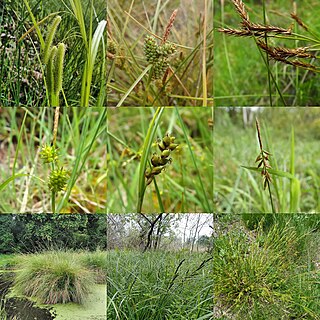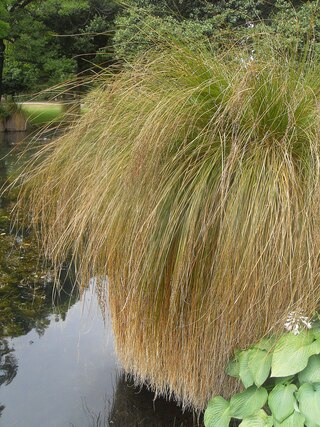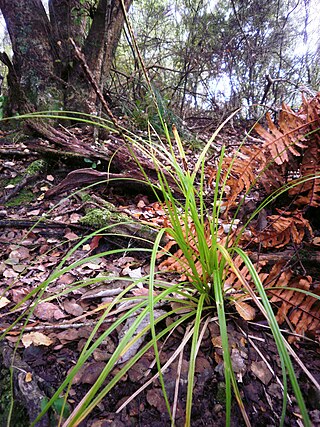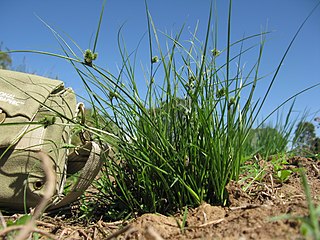
The Cyperaceae are a family of graminoid (grass-like), monocotyledonous flowering plants known as sedges. The family is large: botanists have described some 5,500 known species in about 90 genera, the largest being the "true sedges" with over 2,000 species.

Ornamental grasses are grasses grown as ornamental plants. Ornamental grasses are popular in many colder hardiness zones for their resilience to cold temperatures and aesthetic value throughout fall and winter seasons.

Carex is a vast genus of over 2,000 species of grass-like plants in the family Cyperaceae, commonly known as sedges. Other members of the family Cyperaceae are also called sedges, however those of genus Carex may be called true sedges, and it is the most species-rich genus in the family. The study of Carex is known as caricology.

Comandra is a monotypic genus containing the single species Comandra umbellata. Its common names include bastard toadflax, umbellate bastard toadflax, and common comandra. The plant has a disjunct distribution; its four subspecies occur in North America and the Mediterranean.

Uncinia is a genus of flowering plants in the family Cyperaceae, known as hook-sedges in Australia and as hook grasses or bastard grasses in New Zealand. The genus is characterised by the presence of a long hook formed by an extension of the rachilla, which is used to attach the fruit to passing animals (epizoochory), especially birds, and it is this feature which gives the genus its name, from the Latin uncinus, meaning a hook or barb.
NVC community CG5 is one of the calcicolous grassland communities in the British National Vegetation Classification system. It is one of four communities of rank, tussocky grassland associated with low levels of grazing, within the lowland calcicolous grassland group.

Tussock grasses or bunch grasses are a group of grass species in the family Poaceae. They usually grow as singular plants in clumps, tufts, hummocks, or bunches, rather than forming a sod or lawn, in meadows, grasslands, and prairies. As perennial plants, most species live more than one season. Tussock grasses are often found as forage in pastures and ornamental grasses in gardens.

Tussock grasslands form expansive and distinctive landscapes in the South Island and, to a lesser extent, in the Central Plateau region of the North Island of New Zealand. Most of the plants referred to as tussocks are in the genera Chionochloa, Festuca, and Poa, also Carex.

Carex secta is a sedge from the Cyperaceae family that is endemic to New Zealand. It grows in wetlands. Its Māori names include purei, pukio and makura.

Carex uncinata, the Hawai'i birdcatching sedge, hook grass, hook sedge, bastard grass, kamu or matau-a-maui, is a species of flowering plant in the sedge family, Cyperaceae.

Carex sylvatica is a species of sedge found in deciduous woodlands across Europe. It typically reaches 60 cm (24 in) tall, and has an inflorescence made up of 3–5 pendent female spikes and a single male spike. It is also used as a garden plant, and has been introduced to North America and New Zealand.

Elizabeth Edgar was a New Zealand botanist, best known for her work in authoring and editing three of the five volumes of the series Flora of New Zealand, which describes and classifies the species of flora of the country. She was most noted for her taxonomic work on the biodiversity of New Zealand and was recognised as the foremost authority on nomenclature and description of the country's plants.

Carex inversa, commonly known as knob sedge, is a species of sedge of the family Cyperaceae that is native to parts of Australia and New Zealand and has also been introduced into Great Britain.

Carex pumila, commonly known as strand sedge or spreading sedge, is a species of sedge of the family Cyperaceae.

Carex buchananii, common names Buchanan's sedge, cutty grass, is a species of sedge. It is endemic to New Zealand, being found on both the North and South Islands.

Carex erebus is a member of the sedge family and is found on the Antarctic Islands of Australia and New Zealand.

Carex bohemica is a species of sedge, native to Europe, Siberia, and northern Asia to Japan, and it was introduced to Sweden. It prefers to grow in mud flats. It is called Zypergras-Segge in German.
Carex imbecilla, the feeble bastard grass, is a species of flowering plant in the family Cyperaceae, native to New Zealand. It is often found growing on or near rotten logs.

Carex corynoidea, fish hooks, is a species of flowering plant in the sedge family Cyperaceae, native to New Zealand. A perennial of montane forests, its chromosome number is 2n = 88.
Carex healyi, the harsh-leaved bastard grass, is a species of flowering plant in the family Cyperaceae, native to New Zealand. Found in a wide variety of habitats but preferring semi-shade, its chromosome number is 2n = 88.
















